|

|
|
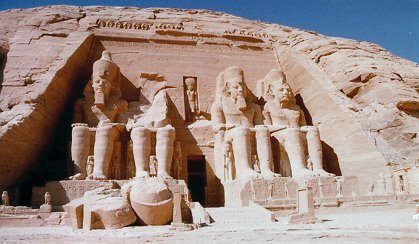 The Greater
Abu Simbel Temple dedicated to the sun god, Ra-Harakhte, Amun-Re,
Ptah, and the deified Ramesses II.
This is the grandest and most beautiful of temples. The facade is 33 meters high , 38
meters wide, and guarded by four statues of Ramesses II wearing the double crown and the
nemes head cloth, each of which is 20 meters high. High on the facade there is a carved row
of baboons, smiling at the sunrise. The Greater
Abu Simbel Temple dedicated to the sun god, Ra-Harakhte, Amun-Re,
Ptah, and the deified Ramesses II.
This is the grandest and most beautiful of temples. The facade is 33 meters high , 38
meters wide, and guarded by four statues of Ramesses II wearing the double crown and the
nemes head cloth, each of which is 20 meters high. High on the facade there is a carved row
of baboons, smiling at the sunrise. |
|
|
|
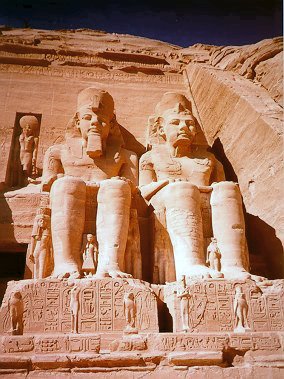 On the doorway of the temple there is a beautiful inscription
of the pharaoh's name, Ser-Ma'at-Ra, and between the legs of the colossal statues on the
facade, there are smaller statues of Ramesses II's family: his mother, Queen Tuya, his wife,
Nefertari, and his sons and daughters.
There are also a number of dedications, important amongst is Ramesses II's marriage to the
daughter of the King of Hittites. On the doorway of the temple there is a beautiful inscription
of the pharaoh's name, Ser-Ma'at-Ra, and between the legs of the colossal statues on the
facade, there are smaller statues of Ramesses II's family: his mother, Queen Tuya, his wife,
Nefertari, and his sons and daughters.
There are also a number of dedications, important amongst is Ramesses II's marriage to the
daughter of the King of Hittites. |
|
|
|
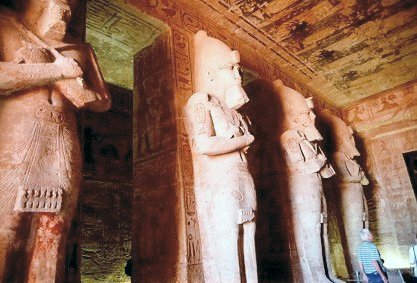 Inside the main temple at Abu Simbel is the Great Hall of
Pillars, with eight pillars bearing the deified Ramesses II in the shape of Osiris. The walls of this hall bear
inscriptions recording the Battle of Kadesh waged by Ramesses II against the Hittites. The
Great Hall leads to the smaller hall of the nobles, containing four square pillars
followed by a vestibule and a sanctuary. Inside the main temple at Abu Simbel is the Great Hall of
Pillars, with eight pillars bearing the deified Ramesses II in the shape of Osiris. The walls of this hall bear
inscriptions recording the Battle of Kadesh waged by Ramesses II against the Hittites. The
Great Hall leads to the smaller hall of the nobles, containing four square pillars
followed by a vestibule and a sanctuary. |
|
|
|
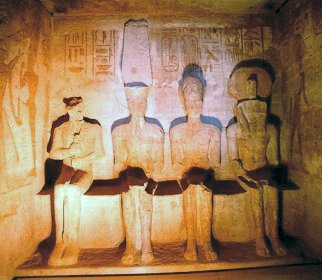 The Sanctuary contains four seated statues of Ptah,
Amun-Re, Ramesses II and Ra-Harakhte. This temple is unique because the rising sun
illuminates the sanctuary and the seated statues of the gods at the rearmost point of the temple two
days a year: February 21, Ramesses' birthday, and October 22, his coronation date. The Sanctuary contains four seated statues of Ptah,
Amun-Re, Ramesses II and Ra-Harakhte. This temple is unique because the rising sun
illuminates the sanctuary and the seated statues of the gods at the rearmost point of the temple two
days a year: February 21, Ramesses' birthday, and October 22, his coronation date. |
|
|
|
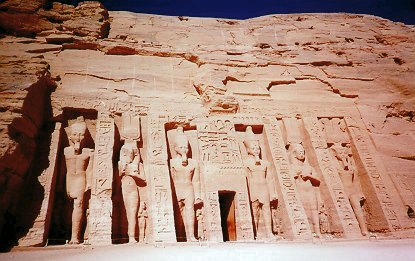 Located a little to the north of the Greater Temple,
lies a smaller rock-cut temple
dedicated to the goddess of Love and Beauty, Hathor, and also to Ramesses'
favorite wife, Nefertari. The Facade is adorned by six statues, four of Ramesses II and
two of Nefertari. The statues of Nefertari are the same height as those of Ramesses, which
is unusual. Like at Ramesses II's temple, there are children depicted around their
feet. Located a little to the north of the Greater Temple,
lies a smaller rock-cut temple
dedicated to the goddess of Love and Beauty, Hathor, and also to Ramesses'
favorite wife, Nefertari. The Facade is adorned by six statues, four of Ramesses II and
two of Nefertari. The statues of Nefertari are the same height as those of Ramesses, which
is unusual. Like at Ramesses II's temple, there are children depicted around their
feet. |
|
|
|
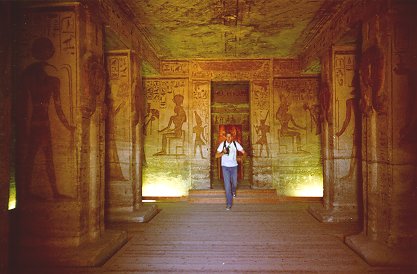 Inside
Nefertari's temple there is a hall containing six pillars bearing the head of the goddess
Hathor. Inside
Nefertari's temple there is a hall containing six pillars bearing the head of the goddess
Hathor. |
|
|
|
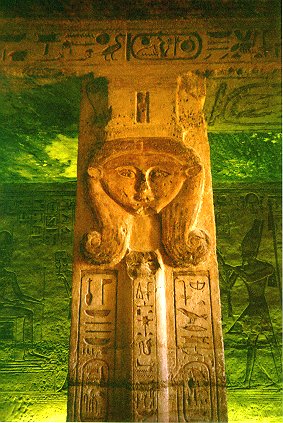 One of the six pillars bearing the head of the goddess Hathor. One of the six pillars bearing the head of the goddess Hathor. |
|
|
|
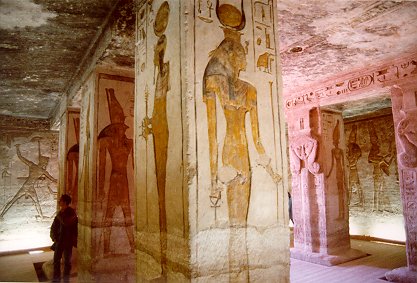 Beyond the hall with the six Hathor pillars is a
vestibule and finally a sanctuary where a statue of Hathor protects Ramesses II. Beyond the hall with the six Hathor pillars is a
vestibule and finally a sanctuary where a statue of Hathor protects Ramesses II. |
|
|
|
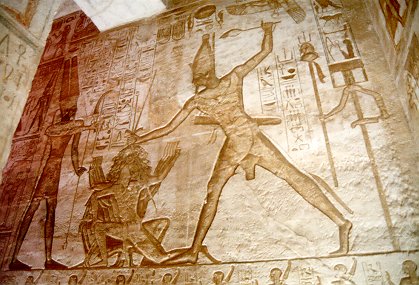 The eastern wall of
the smaller temple bears inscriptions depicting Ramesses II striking the enemy before
Ra-Harakhte and Amun-Re. The eastern wall of
the smaller temple bears inscriptions depicting Ramesses II striking the enemy before
Ra-Harakhte and Amun-Re.
|
|
|
|
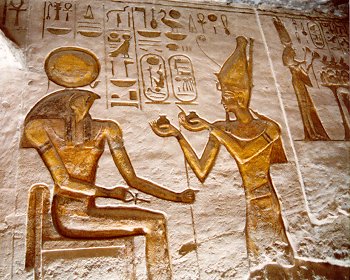 Other
wall scenes show Ramesses II and Nefertari offering incense to the gods. Other
wall scenes show Ramesses II and Nefertari offering incense to the gods. |
|
|
|
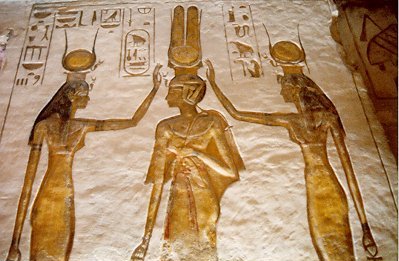 Hathor & Isis
blessing Nefertari inside the smaller Abu Simbel temple Hathor & Isis
blessing Nefertari inside the smaller Abu Simbel temple |
|
|
|
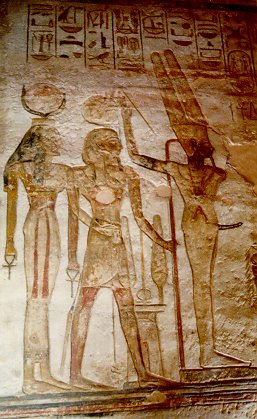 Isis,
Ramesses(?) and Min, the fertility
God, on a panel inside Nefertari's Temple Isis,
Ramesses(?) and Min, the fertility
God, on a panel inside Nefertari's Temple |
|
|
|
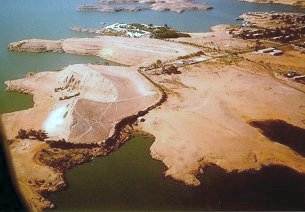 The Abu Simbel temples as seen from the air. The
man-made structures upon which the temples were reconstructed when they were moved to
higher ground can be seen. The Abu Simbel temples as seen from the air. The
man-made structures upon which the temples were reconstructed when they were moved to
higher ground can be seen. |
|
|
|

© All pictures are Copyright 1998 - 2001 Grisel Gonzalez



 |
|
|
|

|

![]()
 The
The  On the doorway of the temple there is a beautiful inscription
of the pharaoh's name, Ser-Ma'at-Ra, and between the legs of the colossal statues on the
facade, there are smaller statues of Ramesses II's family: his mother, Queen
On the doorway of the temple there is a beautiful inscription
of the pharaoh's name, Ser-Ma'at-Ra, and between the legs of the colossal statues on the
facade, there are smaller statues of Ramesses II's family: his mother, Queen  Inside the main temple at Abu Simbel is the Great Hall of
Pillars, with eight pillars bearing the deified Ramesses II in the shape of
Inside the main temple at Abu Simbel is the Great Hall of
Pillars, with eight pillars bearing the deified Ramesses II in the shape of  The Sanctuary contains four seated statues of Ptah,
Amun-Re, Ramesses II and Ra-Harakhte. This temple is unique because the rising sun
illuminates the sanctuary and the seated statues of the
The Sanctuary contains four seated statues of Ptah,
Amun-Re, Ramesses II and Ra-Harakhte. This temple is unique because the rising sun
illuminates the sanctuary and the seated statues of the  Located a little to the north of the Greater Temple,
lies a
Located a little to the north of the Greater Temple,
lies a  Inside
Nefertari's temple there is a hall containing six pillars bearing the head of the goddess
Hathor.
Inside
Nefertari's temple there is a hall containing six pillars bearing the head of the goddess
Hathor. One of the six pillars bearing the head of the goddess Hathor.
One of the six pillars bearing the head of the goddess Hathor. Beyond the hall with the six Hathor pillars is a
vestibule and finally a sanctuary where a statue of Hathor protects Ramesses II.
Beyond the hall with the six Hathor pillars is a
vestibule and finally a sanctuary where a statue of Hathor protects Ramesses II. The eastern wall of
the smaller temple bears inscriptions depicting Ramesses II striking the enemy before
Ra-Harakhte and Amun-Re.
The eastern wall of
the smaller temple bears inscriptions depicting Ramesses II striking the enemy before
Ra-Harakhte and Amun-Re. Other
wall scenes show Ramesses II and Nefertari offering incense to the gods.
Other
wall scenes show Ramesses II and Nefertari offering incense to the gods. Hathor &
Hathor &  The Abu Simbel temples as seen from the air. The
man-made structures upon which the temples were reconstructed when they were moved to
higher ground can be seen.
The Abu Simbel temples as seen from the air. The
man-made structures upon which the temples were reconstructed when they were moved to
higher ground can be seen.